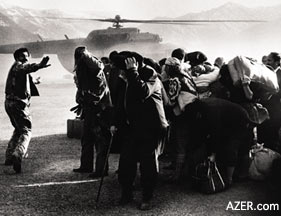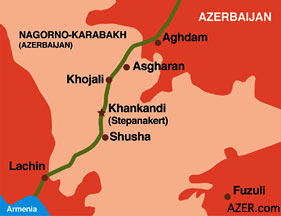|

Spring 2005 (13.1)
Pages
16-17
Remembering Khojali
Finally Documented in U.S. Congressional Record
by
Dan Burton
See articles about Khojali by
Thomas Goltz:
Khojali: Eyewitness
Account From the Following Day (1992), AI 10.1 (Spring 2001)
Khojali: A
Decade of Useless War Remembered, AI 10.1 (Spring 2001)
Khojali:
Facts,
AI 13.1 (Spring 2005)
Khojali:
13
Years Later: Remember, But Be Sure to Preserve Your Souls,
AI 13.1 (Spring 2005)
Khojali: How
to Spell "X-O-J-A-L-I"? AI 10.1 (Spring 2001)
Khojali: Quotes: Never
Forget Khojali and other Massacres by Photographer Reza (1999)
Khojali: Documenting
the Horrors of Karabakh: Chingiz Mustafayev
in Action
by Vahid Mustafayev (AI 7.3, Autumn 1999)
Running For Our Lives: Massacre and
Flight From Khojali - Elman Mammadov, AI 7.3 (Autumn 1999)
  Left: Refugees from mountanious Karabakh,
frantic to flee invading Armenian troops. The war left Azerbaijan
with nearly 1 million refugees in a country of only 8 million.
Photo:
Thomas Goltz. Left: Refugees from mountanious Karabakh,
frantic to flee invading Armenian troops. The war left Azerbaijan
with nearly 1 million refugees in a country of only 8 million.
Photo:
Thomas Goltz.
The following speech regarding the tragic 1992 massacre of
civilians living in Khojali (sometimes spelled Khojaly), Azerbaijan
was delivered by U.S. Representative Dan Burton of Indiana. Thirteen years after the tragic event
took place, the massacre is finally entered into the U.S. Congressional
record.
Burton addressed the House of Representatives on Thursday, February
17, 2005.
Mr. Speaker,
For years a number of distinguished Members of this House have
come to the Floor of this Chamber every April to commemorate
the so-called "Armenian Genocide" - the exact details
of which are still very much under debate today almost 90 years
after the events. Ironically and tragically, none of these Members
has ever once mentioned the ethnic cleansing carried out by the
Armenians during the Armenia-Azerbaijan war, which ended a mere
decade ago.
Khojali
was a little known small town in Azerbaijan until February 1992. Today it no longer
exists, and for people of Azerbaijan and the region, the word
"Khojali" has become synonymous
with pain, sorrow, and cruelty. On February 26, 1992, the
world ended for the people of Khojali when Armenian troops supported by a
Russian infantry regiment did not just attack the town but razed
it to the ground. In the process the Armenians brutally murdered
613 people, annihilated whole families, captured 1,275 people,
left 1,000 civilians maimed or crippled, and another 150 people
unaccounted for in their wake.
Memorial, a Russian human rights group, reported that "scores
of the corpses bore traces of profanation. Doctors on a hospital
train in Aghdam noted no less than four corpses that had been
scalped and one that had been beheaded....and one case of live
scalping."
Various other witnesses reported horrifying details of the massacre.
The late Azerbaijani
journalist Chingiz Mustafayev, who was the first to film the aftermath
of the massacre, wrote an account of what he saw. He said: "Some
children were found with severed ears; the skin had been cut
from the left side of an elderly woman's face; and men had been
scalped." Human Rights Watch called the tragedy at the time
"the largest massacre to date in the conflict". The
New York Times wrote about "truckloads of bodies" and
described acts of "scalping". [Page: E285]
  Left: Close-up of map showing Khojali in
Nagorno-Karabakh. Left: Close-up of map showing Khojali in
Nagorno-Karabakh.
This savage
cruelty against innocent women, children and the elderly is unfathomable
in and of itself, but the senseless brutality did not stop with
Khojali. Khojali was simply the first.
In fact, the level of brutality and the unprecedented atrocities
committed at Khojali set a pattern of destruction and ethnic
cleansing that Armenian troops would adhere to for the remainder
of the war. On November 29, 1993, Newsweek quoted a senior US
Government official as saying, "What we see now is a systematic
destruction of every village in their (the Armenians') way. It's
vandalism."
This year, as they have every year since the massacre, the leaders
of Azerbaijan's Christian, Jewish, and Muslim communities have
issued appeals on the eve of commemoration of the massacre of
Khojali urging the international community to condemn the February
26, 1992 bloodshed, facilitate liberation of the occupied territories
and repatriation of the displaced communities. And every year,
those residents of Khojali, who survived the massacre - many
still scattered among one million refugees and displaced persons
in camps around Azerbaijan - appeal with pain and hope to the
international community to hold Armenia responsible for this
crime.
I'm pleased to say that on January 25, 2005, the Parliamentary
Assembly of the Council of Europe overwhelmingly adopted a resolution
highlighting that "considerable parts of Azerbaijan's territory
are still occupied by the Armenian forces and separatist forces
are still in control of the Nagorno-Karabakh region." It
also expressed concern that the military action between 1988
and 1994 and the widespread ethnic hostilities which preceded
it "led to large-scale ethnic expulsion and the creation
of mono-ethnic areas which resemble the terrible concept of ethnic
cleansing."
Mr. Speaker, this is not the ringing condemnation that the survivors
of Khojali deserve, but it is an important first step by an international
community that has too long been silent on this issue. Congress
should take the next step and I hope my colleagues will join
me in standing with Azerbaijanis as they commemorate the tragedy
of Khojali. The world should know and remember.
_____
Dan Burton,
a Republican from Indiana, was first elected to the U.S. Congress
in November 1982. He currently serves on the House Committee
for International Relations.
Back to Index AI 13.1 (Spring
2005)
AI Home
| Search | Magazine
Choice
| Topics
| AI Store | Contact us
Other Web sites
created by Azerbaijan International
AZgallery.org | AZERI.org | HAJIBEYOV.com
|


